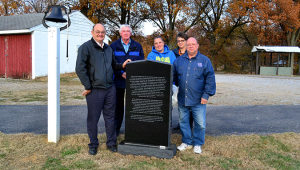OC Chamber ribbon cutting at Trophy House Nov. 22
Motor fuels tax rate to decline by 4.3 cents per gallon on Jan. 1

Kentucky’s “gas tax” on sales of gasoline, diesel and ethanol motor fuels will drop by 4.3 cents per gallon on New Year’s Day, resulting in a loss to the Kentucky Road Fund of about $129 million on an annualized basis.
The decrease reflects a drop in the calculated average wholesale price (AWP) of motor fuels, as provided under Kentucky law.
“The gas tax accounts for more than half of the revenue in the Kentucky Road Fund,” Kentucky Transportation Secretary Mike Hancock said. “A loss of revenue is always concerning, but a revenue impact of this magnitude is crippling. It means less money for building, improving, maintaining and repairing our roads, streets and bridges.”
A loss of $129 million would amount to about 6 percent of Kentucky’s highway program, which was forecast to have $2.25 billion in the current fiscal year from all sources, including state and federal motor-fuels taxes and a state usage tax on motor vehicles.
The highway program is a classic example of a user fee system. Rather than being funded through general taxes on sales, income, payroll or property, Kentucky roads and bridges are paid for by those who use them.
The main user fee is the tax on motor fuels, which is paid at the pump and has two components:
· Variable excise tax.
· Fixed, supplemental user fee of 5 cents per gallon for gasoline and 2 cents per gallon for diesel and other “special fuels.”
There also is a state fee that is paid at the pump – 1.4 cents per gallon – for cleanup of old underground fuel storage tanks. And there is a federal tax of 18.4 cents per gallon of gasoline and 24.4 cents per gallon of diesel. The federal tax is not indexed for inflation and has not changed since 1993.
The Kentucky Transportation Cabinet relies on the Road Fund for its activities, and a dramatic decrease in motor fuels tax revenue could delay or require cancellation of planned projects. Local governments also would feel the pinch because nearly half of the motor-fuels tax – 48 percent – is returned to cities and counties in the form of revenue sharing for local streets and roads.
The state excise tax was enacted in 1920. But in the 1980s, the Kentucky Legislature provided for a variable excise tax as a percentage of AWP of gas, diesel and ethanol fuels.
The variable excise tax rate is 9 percent of AWP, so the tax rises, falls or stays unchanged from quarter to quarter on the basis of a survey of AWP of motor fuels. The survey is conducted by the Department of Revenue in the first month of each quarter (January, April, July and October) and the change in rate – if any – takes effect on the first day of the first month of the following quarter.
For purposes of the excise tax rate, the amount of any increase in the AWP is capped at 10 percent, per year. The Legislature imposed the cap to protect the public at a time when pump prices were skyrocketing. But the Road Fund was not accorded the same protection against dramatic declines in fuel prices. The only limit is a “statutory floor” – a minimum AWP for tax calculation purposes.
Since April 2009, that floor has been $1.786 per gallon – far below the actual AWP, which was surveyed at $2.354 per gallon in October, down from $2.837 in the July survey.
By virtue of the October 2014 survey, the state variable excise tax will decline by 4.3 cents per gallon on Jan. 1, 2014 – to 21.2 cents per gallon from 25.5 cents.
When the supplemental tax of 5 cents and underground petroleum tank fee of 1.4 cents are added, the total state tax and fee paid by motorists will be 27.6 cents per gallon, down from the current 31.9 cents per gallon.
The decline in the tax will be the fourth drop in the last five quarters. The decline will have been 4.9 cents – a $147 million annualized impact – since the fiscal year began on July 1.
In testimony this week to the Legislature’s Interim Budget Review Subcommittee on Transportation, Russ Romine, Deputy Secretary of the Kentucky Transportation Cabinet, pointed out that the January 2015 survey will determine the tax rate for the final quarter of fiscal 2015. Any increase after that would be capped at 10 percent for all of fiscal 2016.
If the AWP declines even more in the January survey, as happened in January 2014, it will take years for the tax rate to recover to the July 2014 level.
Ohio Co. real estate transfers for Nov. 20
Poor Farm Monument unveiled at golf course

 The Ohio County Poor Farm Cemetery monument placed at the Ohio County Community Golf Course. Pictured L-to-R: Judge-Executive David Johnston, Magistrate Kenny Autry, Kristina Chapman, Renetta Romero and Earl Jones.[/caption]
A small group gathered at the Ohio County Community Golf Course to unveil the newly placed monument commemorating the old Ohio County Poor Farm Cemetery on a cold Wednesday afternoon last week.
Judge-Executive David Johnston said that the original poor farm was created by the county in 1887 when it set aside $500 for the project.
One side of the monument lists all of the names of those that were buried in the cemetery and the back tells the story of the Ohio County Poor Farm.
The Ohio County Poor Farm Cemetery monument placed at the Ohio County Community Golf Course. Pictured L-to-R: Judge-Executive David Johnston, Magistrate Kenny Autry, Kristina Chapman, Renetta Romero and Earl Jones.[/caption]
A small group gathered at the Ohio County Community Golf Course to unveil the newly placed monument commemorating the old Ohio County Poor Farm Cemetery on a cold Wednesday afternoon last week.
Judge-Executive David Johnston said that the original poor farm was created by the county in 1887 when it set aside $500 for the project.
One side of the monument lists all of the names of those that were buried in the cemetery and the back tells the story of the Ohio County Poor Farm.
Ohio County Poor Farm was in existence from at least 1851 to after 1950 serving a population of black and white races, ages from infants to nearly 100. The residents included orphans, crippled, elderly, infirm, blind and people with no other place to live, usually numbering 7 to 22 residents. An earlier location was sold in 1873. This location was purchased in 1871, from John & Sally Ann Pirtle a farm 'for the use and benefit of the county paupers.' One hundred acres of this property was advertised for sale in 1883, again in 1897 (to build a new poorhouse or almshouse) again in 1918. It being sold in 1958 with the money from the sale to be used for addition to Ohio County Hospital. Ohio County repurchased this land in 2012. In 1904, dedication of new chapel for the Ohio County Poor Farm. 'The little chapel has been erected mainly for the edification and accommodation of the inmates of the county infirmary, and although of humble pretentions, is an elegant little structure. It is thought to be the only chapel of a county poorhouse in Kentucky. It adjoins the west wing of the main structure, and is so built that is can be reached by the inmates without stepping upon the ground.' The cemetery was used for residents of the poor farm, transients and other county residents, it was not moved but original tombstones were eradicated to allow for golf course construction.[gallery link="file" ids="24380,24379,24378"]
State’s jobless rate plunges to 6.2 percent in Oct.
Hartford City Council meeting today at 4 p.m.
Promise Home, Inc. denied permit to use building as homeless shelter

 The Ohio County Baptist Association building on Center Street in Hartford. The Baptist Association had agreed to rent the building as a homeless shelter for $1 per month if the Joint Board of Adjustments had allow for a Conditional Use permit to be issued for the shelter's operation in a business district.[/caption]
The Ohio County Baptist Association building on Center Street in Hartford. The Baptist Association had agreed to rent the building as a homeless shelter for $1 per month if the Joint Board of Adjustments had allow for a Conditional Use permit to be issued for the shelter's operation in a business district.[/caption]
Emotions, concerns and a battery of questions filled a two-hour night, as members of the public and Joint Board of Adjustments (JBOA) converged at a Beaver Dam/Hartford Planning and Zoning public hearing on Nov. 13 at the Beaver Dam City Building. The purpose of the meeting was to discuss the possibility of granting a Conditional Use permit to a proposed homeless shelter site.
Members from the JBOA opened the hearing around 6:05 p.m. to discuss and gain feedback from the public on whether to vote for or against granting a Conditional Use permit to The Promise Home, Inc. The Promise Home, Inc. is a nonprofit organization formed to provide the displaced residents of Ohio County a homeless shelter.
The organization wanted to rent the Ohio County Baptist Association building on 127 E. Center Street in Hartford, and make it the Promise Home shelter. The purpose of the Conditional Use permit was to allow the nonprofit organization to use the building as a shelter for the homeless and those in need as the building is in an area zoned as a business district.
Only Chairperson Nick White and member Dannie Overton were present at the beginning of the meeting, and at least three of the five board members needed to be present in the beginning for a majority to be counted. Secretary Vince Tanner and member Larry Smith arrived later in the meeting, while Vice Chairperson Patsy Vance was absent.
Angela Porter-Stewart, the vice chair of The Promise Home, Inc., made her opening statement saying the organization wanted to serve up to 40 people in the shelter, but would take it slow in the beginning. And when it came to supporting such a venture, she said Ohio County Judge-Executive David Johnston and the fiscal court were behind the project.
“In the (Oct. 28 fiscal court) meeting, the magistrates allotted some of their discretionary funds to assist with this,” she said.
During the public comments, many concerns were expressed about the possible adverse effects that would come to the area if such a shelter was built. The chief concerns included a lack of parking space and privacy, decrease in public safety and property value and stifling of business growth.
The JBOA also had a number of questions, such as, what would be involved in an applicant’s background check and who would run them? Are there experienced managers that have a background in managing homeless shelters within the organization’s current group and who will be the sole responsible member of the shelter when it opens?
After a little over an hour into the hearing, the mounting concerns and questions from both sides began to weigh heavily on Porter-Stewart. As she was explaining how the Baptist Association was going to charge her organization a dollar a month for rent, she talked about her work sheltering homeless children, and her voice began to waver.
“[The rent] is a dollar a month, and to get these children that I’ve been working with over the past year under a roof, out of this cold, [and] in the rain, I’m going to do it. And I’m going to fight to do it! We gotta have this whether it’s here or somewhere else. I don’t have any more tents to give out,” Porter-Stewart said as she shed a couple of tears.
While many of the participants recognized the need for a homeless shelter and commended Porter-Stewart on her work with the project, the general feeling was the Baptist Association building may not have been the best proposed site, due to the number of adverse effects that it could bring to the area.
On Nov. 17, White sent a document to the Ohio County Monitor which stated the JBOA declined The Promise Home, Inc., a Conditional Use permit for the Baptist Association building. According to White, before making their decision, the JBOA took into consideration the organization’s permit request, its business plan, Porter-Stewart’s testimony, and project sponsors, as well as comments made by property owners, area residents, and community leaders.
The reason for the denial was the board “found the character, nature and requirements of a multi-family like, medium-term, transitional residence for the homeless was incompatible with the character and nature of the high density, B-1 zoned, Central Business District,” as defined by the Zoning Ordinance and the Comprehensive Plan’s developmental goals and objectives.
Even though the JBOA denied the nonprofit organization the Conditional Use permit, they noted in the document, they too recognize a need for such an establishment and listed a couple of suggestions to help reduce Ohio County’s homeless situation.
The first was for the Hartford and Beaver Dam city governments, the Ohio County Emergency Management team, local churches and charitable organizations, to provide immediate temporary emergency shelters for Ohio County’s homeless during the unseasonably cold weather. The second was to set up a working committee to help The Promise Home, Inc., and other charitable organizations, build a practical homeless and transitional shelter for Ohio County.
After the board's decision, Porter-Stewart was still incredibly hurt by the entire process. She said during the meeting, she felt like she was on trial for murder.
“That was very brutal, very cold, I felt like,” she said.
When Porter-Stewart first learned about the JBOA’s decision to deny The Promise Home the Conditional Use permit, she cried.
“I bawled like a baby. Then, I just got my composure and just told God to lead me to where I’m supposed to go,” she said.
However, Porter-Stewart said it was the JBOA’s right to hold an opposing side and she respects them for it. She believes they did their job very well and commends them for it. She also believes the meeting may have not been for acquiring the building, but for another reason.
“It may be just to open some people’s eyes and just get the word out a little more about the homeless situation that we do have here in the county, and all I can do is pray about it and pray that God will show us where we need to go,” she said.
This bump in the road isn’t stopping her from helping the homeless. She will now be looking into other potential pieces of property for the shelter, while crunching the numbers along the way to see where the organization can go from here.
To view a PDF of the JBOA's ruling, click here.
Southern Elementary special-called SBDM Council meeting Nov. 24
James Vollie Lee Geary
Hettie Thompson

 Hettie Thompson, 93, of Pleasant Ridge, Ky., died Thursday, Nov. 20, 2014, at Hermitage Care & Rehabilitation in Owensboro. She was born Oct. 23, 1921, in Ohio County to the late Harlin and Ethel Lloyd Wigginton.
She was an 84 year member of the Pleasant Ridge Baptist Church and a past member of the Order of the Eastern Star and Indian Hills Archery Club. She enjoyed walking, singing, reading and quilting.
She was preceded in death by her first husband, Sim Ray Tabor; second husband, Tommie Thompson; three brothers, Larry (Dorothy), Edwin (Nadine), and Dan (Mae) Wigginton; three sisters, Clarice (Archie) Smith, Norma (James) Evans, and Anna Laura Medlin; and grandson, Eric Parks.
She is survived by her son, Major (Ret.) Carlton (Betty) Tabor, of Beebe, Ark.; daughters, Vivian (Richard) Brooks, of Owensboro, Ethel Darlene (Richard) McQueen, of Hutto, Texas, Vicki (Jerry) Gentry, of Henderson, and Sean (Brad) Smith, of Laurel Hills, Fla.; 11 grandchildren, Sim Parks, Ginger (Ricky) Leonard, Ben Brooks, Lisa, Hettie, and Carl Tabor, Kelley Morris, Ryan (Jessica) Ford, Emily (Robert) Quinn, Brad (Carrie) Gentry, and Travis (Sarah) Westerfield; 14 great grandchildren, Dylan and Shaleigh Morris, Cassidy Adkins, Jared and Jacob Tabor, Jacquelyn and Charlotte Ford, Evan Quinn, Samuel and Elijah Gentry, Alyce, Noah, Levi, and Owen Westerfield; and many nieces and nephews.
Services are 1 p.m. on Monday, Nov. 24, at the Chapel of James H. Davis Funeral Home & Crematory in Owensboro. Burial is in Mount Carmel Baptist Church Cemetery in Ohio County, KY. Visitation is from 2 a.m. until 6 p.m. on Sunday and after 11 a.m. on Monday at the funeral home.
Expressions of sympathy may take the form of donations to Pleasant Ridge Baptist Church, 4195 Ky. 764, Utica, Ky. 42376.
Hettie Thompson, 93, of Pleasant Ridge, Ky., died Thursday, Nov. 20, 2014, at Hermitage Care & Rehabilitation in Owensboro. She was born Oct. 23, 1921, in Ohio County to the late Harlin and Ethel Lloyd Wigginton.
She was an 84 year member of the Pleasant Ridge Baptist Church and a past member of the Order of the Eastern Star and Indian Hills Archery Club. She enjoyed walking, singing, reading and quilting.
She was preceded in death by her first husband, Sim Ray Tabor; second husband, Tommie Thompson; three brothers, Larry (Dorothy), Edwin (Nadine), and Dan (Mae) Wigginton; three sisters, Clarice (Archie) Smith, Norma (James) Evans, and Anna Laura Medlin; and grandson, Eric Parks.
She is survived by her son, Major (Ret.) Carlton (Betty) Tabor, of Beebe, Ark.; daughters, Vivian (Richard) Brooks, of Owensboro, Ethel Darlene (Richard) McQueen, of Hutto, Texas, Vicki (Jerry) Gentry, of Henderson, and Sean (Brad) Smith, of Laurel Hills, Fla.; 11 grandchildren, Sim Parks, Ginger (Ricky) Leonard, Ben Brooks, Lisa, Hettie, and Carl Tabor, Kelley Morris, Ryan (Jessica) Ford, Emily (Robert) Quinn, Brad (Carrie) Gentry, and Travis (Sarah) Westerfield; 14 great grandchildren, Dylan and Shaleigh Morris, Cassidy Adkins, Jared and Jacob Tabor, Jacquelyn and Charlotte Ford, Evan Quinn, Samuel and Elijah Gentry, Alyce, Noah, Levi, and Owen Westerfield; and many nieces and nephews.
Services are 1 p.m. on Monday, Nov. 24, at the Chapel of James H. Davis Funeral Home & Crematory in Owensboro. Burial is in Mount Carmel Baptist Church Cemetery in Ohio County, KY. Visitation is from 2 a.m. until 6 p.m. on Sunday and after 11 a.m. on Monday at the funeral home.
Expressions of sympathy may take the form of donations to Pleasant Ridge Baptist Church, 4195 Ky. 764, Utica, Ky. 42376.
Paul Smith

 Paul Smith, 81, of Owensboro, died Nov. 20, 2014. He was born to J.B. and Mary Rose Collignon Smith on Aug. 13, 1933.
Paul was a member of St. Anthony Parrish. He graduated from Catholic High.
Paul enlisted in the Navy, fighting in the Korean War for three years and an additional four years in the Air Force Reserve. He was a unique individual. Paul could make anything mechanical work, he wrote poetry, and made a replica of a pioneer village. Paul was a wine maker and loved to hunt in his younger years. He loved to travel during his happiest days with Barbara on trips to Alaska.
Paul was preceded in death by the mother of his children, Irene Whitney Smith; brother-in-law, J.R. Bryant; and sister-in-law, Jane Smith.
Survivors include his wife of 19 years, Barbara Smith; daughter, Susan Ward, of Owensboro; sons, David Smith, of Utica, and Tim Smith, of Fordsville; three stepsons, Toby (Tamanda) Barnett, of Rusellville, Ky., Tyler (Kim) Barnett, of Owensboro; Todd (Autumn) Barnett, of Owensboro; grandchildren, Shaune Ward, of Owensboro, Ashley (Darrell) Singleton, of Elizabethtown, Austin Barnett, of Lexington, Rachel Barnett and David Barnett, of Russellville, Desmond Barnett, Trent Barnett, McKenzie Barnett, Mya Barnett, all of Owensboro; great-grandchildren, Braydon, Jade, and Maci Singleton, all of Elizabethtown.
Service will be 12 p.m. Saturday at St. Anthony Parrish. Burial will follow at St. Anthony Cemetery. Visitation will be from 4 p.m. until 8 p.m. Friday and from 9 a.m. until 11:15 a.m. Saturday at Glenn Funeral Home and Crematory.
Condolences may be left for the family at: www.glennfuneralhome.com.
Paul Smith, 81, of Owensboro, died Nov. 20, 2014. He was born to J.B. and Mary Rose Collignon Smith on Aug. 13, 1933.
Paul was a member of St. Anthony Parrish. He graduated from Catholic High.
Paul enlisted in the Navy, fighting in the Korean War for three years and an additional four years in the Air Force Reserve. He was a unique individual. Paul could make anything mechanical work, he wrote poetry, and made a replica of a pioneer village. Paul was a wine maker and loved to hunt in his younger years. He loved to travel during his happiest days with Barbara on trips to Alaska.
Paul was preceded in death by the mother of his children, Irene Whitney Smith; brother-in-law, J.R. Bryant; and sister-in-law, Jane Smith.
Survivors include his wife of 19 years, Barbara Smith; daughter, Susan Ward, of Owensboro; sons, David Smith, of Utica, and Tim Smith, of Fordsville; three stepsons, Toby (Tamanda) Barnett, of Rusellville, Ky., Tyler (Kim) Barnett, of Owensboro; Todd (Autumn) Barnett, of Owensboro; grandchildren, Shaune Ward, of Owensboro, Ashley (Darrell) Singleton, of Elizabethtown, Austin Barnett, of Lexington, Rachel Barnett and David Barnett, of Russellville, Desmond Barnett, Trent Barnett, McKenzie Barnett, Mya Barnett, all of Owensboro; great-grandchildren, Braydon, Jade, and Maci Singleton, all of Elizabethtown.
Service will be 12 p.m. Saturday at St. Anthony Parrish. Burial will follow at St. Anthony Cemetery. Visitation will be from 4 p.m. until 8 p.m. Friday and from 9 a.m. until 11:15 a.m. Saturday at Glenn Funeral Home and Crematory.
Condolences may be left for the family at: www.glennfuneralhome.com.
Mary Ethel Roach Philpot

 Mary Ethel Roach Philpot,72, of Beaver Dam, went to be with the Lord on Monday, Nov. 17, 2014, at Ohio County Hospital. She was born March 6, 1942, in Fordsville to the late Henry Roach, Sr. and Emma Evans Roach.
She was a homemaker, had 12 children and has worked as a nursing home assistant and chauffeur. She was of the Christian faith, prayed and read the Bible regularly. She loved to sing, liked conversation and enjoyed company. She would help anybody in need, any way she could, even if it meant her last dollar. Her passion was driving and meeting people, and she never met a stranger. She will be missed by many people.
Mary Ethel was also preceded in death by her husband, Roy James Philpot, Sr.; and brothers, Henry Roach, Jr. and Robert "Bob" Roach.
Survivors include her children, Roger (Amanda) Roach Philpot, Roy J. Philpot, Jr., and Ronald J. Philpot, all of Beaver Dam, Robert D. Philpot and Renee J. Hill, both of Owensboro, Johnny Borden, Sherri Ann Borden and Jennie Faye Borden, all of Indiana, Ima Doreen Borden, of Ohio County, Deana Richards and Kimberly Taylor Mattingly, both of Fordsville and Lisa Lanham of Central City; brothers, Ivan Roach and John Roach, both of Fordsville, and Fred Roach, of Virginia; sisters, Peg Harder, of Dundee and Susan Pulliam, of Hawesville; and many dozens of grandchildren and great-grandchildren.
Services will be at 6 p.m. Thursday, Nov. 20, at Geary Funeral Home, Fordsville. Visitation will be 4 p.m. until 8 p.m. Wednesday and after 4 p.m. Thursday at the funeral home.
Mary Ethel Roach Philpot,72, of Beaver Dam, went to be with the Lord on Monday, Nov. 17, 2014, at Ohio County Hospital. She was born March 6, 1942, in Fordsville to the late Henry Roach, Sr. and Emma Evans Roach.
She was a homemaker, had 12 children and has worked as a nursing home assistant and chauffeur. She was of the Christian faith, prayed and read the Bible regularly. She loved to sing, liked conversation and enjoyed company. She would help anybody in need, any way she could, even if it meant her last dollar. Her passion was driving and meeting people, and she never met a stranger. She will be missed by many people.
Mary Ethel was also preceded in death by her husband, Roy James Philpot, Sr.; and brothers, Henry Roach, Jr. and Robert "Bob" Roach.
Survivors include her children, Roger (Amanda) Roach Philpot, Roy J. Philpot, Jr., and Ronald J. Philpot, all of Beaver Dam, Robert D. Philpot and Renee J. Hill, both of Owensboro, Johnny Borden, Sherri Ann Borden and Jennie Faye Borden, all of Indiana, Ima Doreen Borden, of Ohio County, Deana Richards and Kimberly Taylor Mattingly, both of Fordsville and Lisa Lanham of Central City; brothers, Ivan Roach and John Roach, both of Fordsville, and Fred Roach, of Virginia; sisters, Peg Harder, of Dundee and Susan Pulliam, of Hawesville; and many dozens of grandchildren and great-grandchildren.
Services will be at 6 p.m. Thursday, Nov. 20, at Geary Funeral Home, Fordsville. Visitation will be 4 p.m. until 8 p.m. Wednesday and after 4 p.m. Thursday at the funeral home.
OCMS Lady Eagle basketball scores Nov. 4 – Nov. 20
Kentucky State Parks offer holiday events
KSP announces ‘Cram the Cruiser’ to feed the hungry

 Sgt. Michael Webb and Santa Claus (Retired Tpr. Dick Parkos).[/caption]
Sgt. Michael Webb and Santa Claus (Retired Tpr. Dick Parkos).[/caption]
The Kentucky State Police kicked off its fifth annual ‘Cram the Cruiser’ food drive yesterday. Food collection sites have been established at all 16 posts throughout the state and at the agency’s headquarters location in Frankfort. The campaign extends through Dec. 16, 2014 and is designed to collect non-perishable food items for needy families.
KSP spokesman Sgt. Michael Webb said the agency collected more than 124,000 pounds of food during the 2013 campaign.
“We were so pleased with the results, hard work and effort from each of our posts and regions last year,” says Webb. “It is a wonderful opportunity to give back to those in local communities who are struggling financially during the holiday season.”
Webb says the food will be distributed at post level to local shelters, churches or other organizations serving those in need. Suggested donations include canned fruit and vegetables, canned meat, macaroni and cheese, cereal, peanut butter, jelly, canned soups, chili or spaghetti sauce, brownie and cake mixes, coffee, water, powdered milk and juices.
Donations can be dropped off at any KSP post. Visit the KSP website at kentuckystatepolice.org for a listing of the post locations. http://www.kentuckystatepolice.org/post.htm
Ky. Afield Outdoors: 2015-2016 waterfowl seasons look promising

OCHS Powder Puff Football games set for today
Hartford man hospitalized after alchohol related crash

Floyd Henry Nelson Leach
In case you missed it: Nov. 16-22

The Sunday Morning Monitor...
NEWS- KSP arrest man in possession of crack cocaine
- Highway crews cleaning up first snowfall of the season
- Gov. Beshear names Ohio Co. Work Ready Community In Progress
- Beaver Dam man arrested on drug charges after argument
- Help the Ohio Co. Monitor pay the bills with small gesture
- Ohio Co. Hospital prepared for flu, other viruses
- OC Fiscal Court allows Armstrong Col use of road, to install 3,500 ft. of waterline
- Motor fuels tax rate to decline by 4.3 cents per gallon on Jan. 1
- Ohio Co. real estate transfers for Nov. 20
- State's jobless rate plunges to 6.2 percent in Oct.
- Promise Home, Inc. denied permit to use building as homeless shelter
- KSP announces ‘Cram the Cruiser’ to feed the hungry
- Hartford man hospitalized after alcohol related crash
- Community Thanksgiving Service at New Assembly Church Nov. 23
- VIDEO: 2014 OCHS Veterans Day Program
- Poor Farm Monument unveiled at golf course
- Southern Elementary special-called SBDM Council meeting Nov. 24
- Kentucky State Parks offer holiday events
- OC swim team adds 3 newcomers to mix for 2014-15
- Local boy bags 19-point buck as first deer
- OCMS 8th graders edge Grayson, 7th graders fall in OT
- OCMS Lady Eagle basketball scores Nov. 4 - Nov. 20
- Ky. Afield Outdoors: 2015-2016 waterfowl seasons look promising
- OCHS Powder Puff Football games set for today
- Woody Gene Birchwell
- Anna Lois Kitchens
- Herbert F. Crabtree
- Pamela Marie 'Pam' Griffin
- Rev. Wesley Edgar Lindsey
- David Lynn Kessinger
- James Vollie Lee Geary
- Hettie Thompson
- Paul Smith
- Mary Ethel Roach Philpot
- Floyd Henry Nelson Leach